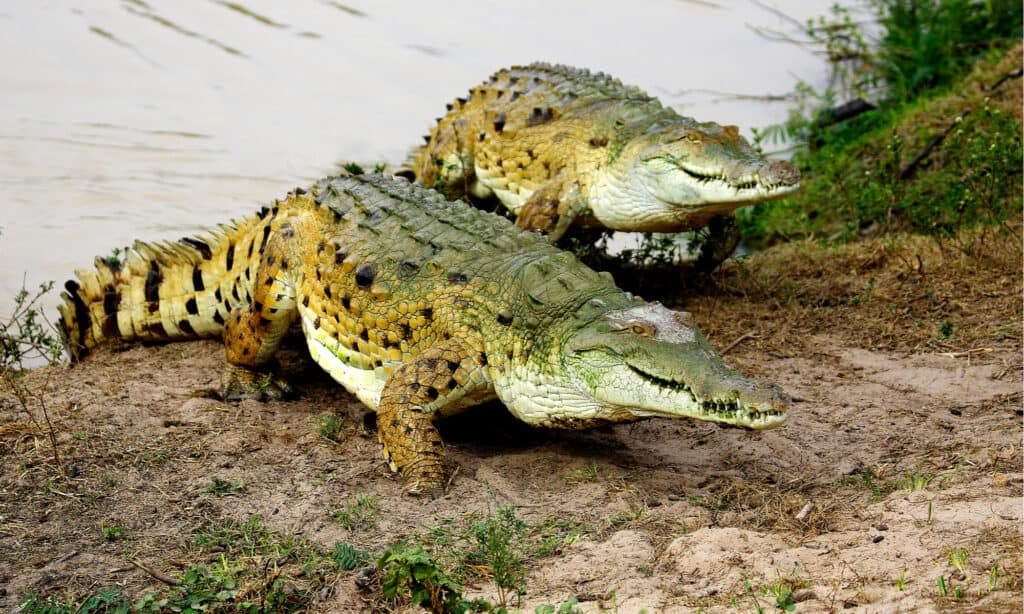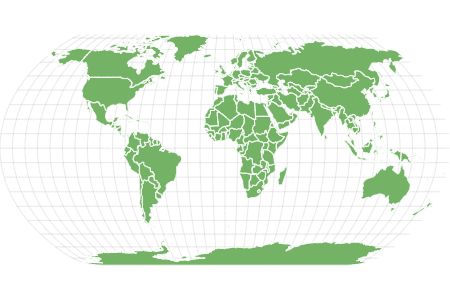Orinoco Crocodile
Crocodylus intermedius
Orinoco crocodiles are the largest predators in South America; they're also going extinct!
Advertisement
Orinoco Crocodile Scientific Classification
- Kingdom
- Animalia
- Phylum
- Chordata
- Class
- Reptilia
- Order
- Crocodylia
- Family
- Crocodylidae
- Genus
- Crocodylus
- Scientific Name
- Crocodylus intermedius
Read our Complete Guide to Classification of Animals.
Orinoco Crocodile Conservation Status
Orinoco Crocodile Facts
- Prey
- large fish, deer, domestic animals, caimans
- Main Prey
- large predatory fish
- Name Of Young
- hatchling
- Group Behavior
- Social
- Group
- Fun Fact
- Orinoco crocodiles are the largest predators in South America; they're also going extinct!
- Estimated Population Size
- 250 to 1500
- Biggest Threat
- humans
- Other Name(s)
- Cocodrilo del Orinoco, Crocodile de l'Orénoque, Colombian crocodile, Venezuelan delta crocodile, Caimán del Orinoco, Caimán del Llanos
- Temperament
- aggressive
- Incubation Period
- Three months
- Age Of Independence
- one to three years
- Litter Size
- 15 to 70 eggs
- Predators
- humans
- Diet
- Carnivore
- Average Litter Size
- 40 eggs
- Lifestyle
- Social
- Group
- Favorite Food
- large fish, aquatic and terrestrial mammals, birds, caimans
- Common Name
- Orinoco crocodile
- Origin
- Venezuela, Colombia
- Location
- Venezuela, Colombia
- Group
- congregation, bask
- Nesting Location
- burrows dug into riverbanks
View all of the Orinoco Crocodile images!
“Orinoco crocodiles are the largest predators in South America; they’re also going extinct!”
Facts
- Orinoco crocodiles are the largest predators in South America. They are also apex predators which means they sit comfortably at the top of the food chain.
- A living fossil: You can trace the Orinoco crocodile back 240 million years ago! They also haven’t changed much in the last 200 million years.
- A crowded smile: The Orinoco crocodile has 68 teeth! This is especially ironic when you consider the fact that they cannot chew their food.
- Endangered species: Orinoco crocodiles are almost extinct. They are endangered animals and only a handful of them remain in the wild.
- Loud and proud: Orinoco crocodiles are very vocal animals and exhibit a wide range of vocal and physical mannerisms that help them communicate with one another.
- Orinoco crocodiles are very sluggish animals. They have such a low metabolism that they can go a few months and sometimes up to three years without food!
Summary
The Orinoco crocodile is a large reptile species living in South America. They are the largest predator in the Americas. They are also critically endangered due to excessive hunting and habitat loss. Conservation efforts have been put in place to protect these reptiles from going extinct.
Scientific Name
Orinoco crocodiles are classified into the Crocodylidae family and genus Crocodylus. Their scientific name is Crocodylus intermedius. Their generic name Crocodylus comes from the Greek words kroko which means “pebble” and deilos which means “worm,” and this refers to the general look of a crocodile’s scaly body. The specific name intermedius is Latin and describes the shape of their snout.
Many believe the Crocodylus has origins in Africa, although some biologists theorize that it may have Australian or Asian roots instead.
Appearance
The Orinoco crocodile is the largest predator in South America and one of the largest reptiles in the world. When their population was still large, some of these reptiles could span a whopping 22 feet in length. However, these days the largest crocodiles reach up to 17 feet maximum. The male crocodiles generally tend to be much bigger than the females, and almost twice their weight. Male crocodiles typically grow to be about 13 feet and 5 inches long and weigh 880 pounds, while the females grow to 12 feet and weigh only 496 pounds.
Orinoco crocodiles are pale in color. They usually come in three colors and are classified as such: amarillo crocodiles are the most common and range from pale tan to yellow with scattered dark spots, negro crocodiles are dark gray or dark brownish-gray, and mariposo crocodiles are grayish-green with dark spots.
They have dark brown markings on their bodies. Orinoco crocodiles have the ability to change the amount of melanin in their hide over time which leads their colors to change.
The Orinoco crocodile has scales, a long snout, short, sturdy legs, webbed feet, and a long, muscular tail. When underwater, the crocodile’s snout stays atop the surface to enable it to breathe whilst remaining virtually undetected by its prey.

The Orinoco crocodile has scales, a long snout, short, sturdy legs, webbed feet, and a long, muscular tail.
©slowmotiongli/Shutterstock.com
Behavior
Orinoco crocodiles are water-savvy reptiles. They are great swimmers and are well adapted to hunting from the water. They have webbed feet which helps them steer while submerged. When in the water, they are able to hunt land animals by launching themselves out of the water with the help of their powerful tails. Orinoco crocodiles usually hunt and eat at night. They are usually slothful animals and tend to only come alive during mealtime.
Orinoco crocodiles are social animals. They create ranking systems or dominance hierarchies wherein there is a dominant individual who presides over the lower-ranking individuals. The males fight for mating privileges, food, water, and other resources. They usually migrate in groups during the dry season seeking a new aquatic habitat when their home river dries up. They are a burrowing species and dig holes at the riverbanks.
Orinoco crocodiles communicate with each other using a wide range of mannerisms. They bellow like lions, thrash their tails, and even emit “infra-sounds.” They emit these barely audible noises when they tremor near the water surface, causing wave ripples. A group of Orinoco crocodiles is called a bask or a congregation.
In terms of temperament, Orinoco crocodiles tend to be aggressive, especially the males.
Diet
Orinoco crocodiles are apex predators which means they are at the top of the food chain in their habitat. They are semiaquatic animals and hunt both animals in water and on land.
Juvenile Orinoco crocodiles mostly prey on small fish, insects, and crabs. The adults eat larger fish, and hunt vertebrate prey such as deer, capybaras, monkeys, birds, caimans, and even other smaller Orinoco crocodiles. They are an opportunistic species and will typically eat anything that they find in their habitat.
Orinoco crocodiles rarely pose a threat to humans. This could largely be due to their dwindled population. There have been cases of Orinoco crocodile attacks on humans, especially in the past. However, these days, these endangered reptiles live apart from the general human population and settlements.
Habitat and Population
Orinoco crocodiles are native to the Orinoco River basin in Venezuela and Colombia. While the Orinoco crocodile used to inhabit a variety of areas including tropical forests and the Andes foothill streams, it is now limited to the Llanos savanna and its related freshwater rivers.
The Orinoco crocodile is Critically Endangered on the IUCN Red List of Threatened Species.
The current population estimate is between 250 and 1500 crocodiles. These crocodiles live in four main protected areas in Venezuela: the Refugio de Fauna Estero de Chiriguare in the Portuguesa state, the Parque Nacional Aguaro-Guariquito in Guarico state, the Parque Nacional Cinaruco-Capanaparo, and the Refugio de Fauna Caño Guaritico, both in the Apure state.
Orinoco crocodiles were widely hunted and killed between the 1930s and the 1960s for their valuable hide. Their skins were used for fashion accessories. They are rare in Venezuela and almost extinct in Colombia. Conservationalists are making efforts to protect the Orinoco crocodile species by breeding them in captivity and reintroducing them into the wild.
These crocs are a protected species in both Venezuela and Colombia, although this protection is not always adequately enforced.
Reproduction and Lifespan
Reproduction of Orinoco crocodiles begins in the dry season which is from January to February. The males attract females with their deep bellows. The deeper the roar, the more likely they will find a mate. Orinoco crocodiles have a polygymous system of mating wherein one male mates with many females. This is because there are usually twice as many females as there are males.
The females and males go back to the holes that they burrowed into the riverbanks to mate. About 14 weeks after mating, the females will dig a hole and lay anywhere from 15 to 70 eggs in it, usually about 40 eggs. They incubate their eggs for around three months and then lay them in burrowed holes. When the eggs hatch, the hatchlings cry out to their mother who carries them to the river. The females protect the nest and her offspring for about one to three years. On average, the young crocodiles become independent at about a year or close to it.
Orinoco females reach sexual maturity at just over 8 feet in length, while the males become mature at 9 feet 10 inches.
Predators and Threats
Orinoco crocodiles are apex predators so no larger animal hunts them. Hatchlings and young crocodiles, however, are prone to predation by larger animals such as jaguars, caimans, American black vultures, and anacondas. Their mothers sometimes fight these predators off or kill them to protect their offspring.
The biggest threat Orinoco crocodiles face is extinction by humans. These reptiles have been hunted to the point of endangerment. The fashion industry uses their hides to make clothing accessories such as bags and shoes. Their population has not recovered yet from this damage and currently they face habitat destruction and the illegal hunting of their teeth, meat, and eggs for food and medicinal purposes.
Related Animals
View all 66 animals that start with OOrinoco Crocodile FAQs (Frequently Asked Questions)
How many Orinoco crocodiles are left in the wild today?
The number of Orinoco crocodiles living in the wild today is between 250 and 1500.
Are Orinoco crocodiles extinct?
Orinoco crocodiles are not extinct, but they are critically endangered. There are only a handful of them left in the wild today.
How long do Orinoco crocodiles live?
Orinoco crocodiles can live up to 70 to 80 years if left alone and unoppressed.
Are Orinoco crocodiles aggressive?
Orinoco crocodiles in captivity are relatively docile, but can become very aggressive, especially if they are new mothers protecting their young. Crocodiles in the wild can be aggressive, but they generally avoid humans and live in isolation from them.
What do Orinoco crocodiles eat?
Orinoco crocodiles are opportunistic carnivores. They eat large predatory fish, land mammals such as deer, birds, domestic animals, and pretty much anything they can find.
Where do Orinoco crocodiles live?
Orinoco crocodiles can be found in their native lands of Venezuela and Colombia. They are semiaquatic and live in the Orinoco river basin.
How big are Orinoco crocodiles?
Orinoco crocodiles are the largest predators in South America. They can grow up to 17 feet long and weigh from 496 to 880 pounds!
What threats do Orinoco crocodiles face today?
Despite being a protected species, Orinoco crocodiles are still hunted by humans for their eggs and meat, and for their teeth which are used for medicinal purposes. They also face loss of their habitat due to human encroachment and destruction.
Thank you for reading! Have some feedback for us? Contact the AZ Animals editorial team.
Sources
- IBG, Available here: https://www.ibg.uu.se/digitalAssets/177/c_177020-l_3-k_martensson-dick-arbete.pdf
- Wikipedia, Available here: https://en.wikipedia.org/wiki/Orinoco_crocodile
- Spain I Naturalist, Available here: https://spain.inaturalist.org/taxa/26081-Crocodylus-intermedius
- Crocodilian, Available here: https://crocodilian.com/cnhc/csp_cint.htm

















